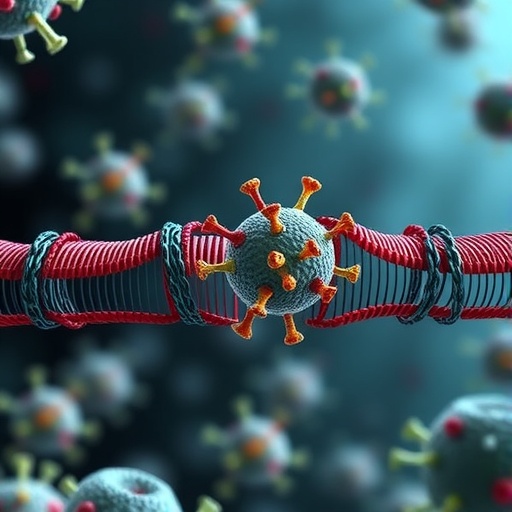
In a groundbreaking study poised to reshape our understanding of microbial pathogenesis, researchers have uncovered a remarkable mechanism by which bacteria collaborate across membrane boundaries to facilitate their survival and propagation inside host cells. This revolutionary finding delves deep into the intracellular battleground, revealing a sophisticated bacterial cooperation strategy that potentially enhances pathogenicity, subverts host defenses, and complicates infection outcomes. The research, conducted by Schator, Kumar, Chong, and their colleagues, and published in Nature Communications in 2025, sheds light on interbacterial communication in confined intracellular niches—an area previously veiled in mystery.
Intracellular pathogenesis, a complex process where bacterial invaders breach host cellular defenses to establish infection, traditionally focuses on individual bacterial behavior or host factors. However, this novel study shifts the paradigm by demonstrating that bacteria do not act in isolation within the host cell cytoplasm or vacuoles. Instead, bacterial populations appear to engage in cooperative interactions involving direct or indirect communication across membrane partitions inside the cell. These interactions enable coordinated responses that improve bacterial endurance, access to nutrients, and evasion of the host’s immune surveillance, offering fresh insights into microbial survival tactics.
Utilizing sophisticated imaging technologies, including advanced fluorescence microscopy and electron microscopy, the research team visualized bacterial clusters localized in distinct but adjacent intracellular compartments. These bacterial communities exhibited dynamic communication mechanisms allowing them to share metabolic resources, signaling molecules, and even gene products across the intervening membranes. Contrary to earlier assumptions that such membranes are impermeable barriers isolating bacterial populations, this study documents transient and regulated permeability that facilitates cross-membrane cooperation with profound implications.
.adsslot_lNAjnJyTcB{width:728px !important;height:90px !important;}
@media(max-width:1199px){ .adsslot_lNAjnJyTcB{width:468px !important;height:60px !important;}
}
@media(max-width:767px){ .adsslot_lNAjnJyTcB{width:320px !important;height:50px !important;}
}
ADVERTISEMENT
A key breakthrough was the identification of molecular conduits or nanostructures bridging the bacterial residents within separate vesicular compartments. These structures appear to act as inter-bacterial highways, transferring crucial effector molecules and metabolites. Intriguingly, some of these exchanges resemble bacterial conjugation systems but adapted for the intracellular environment. The study proposes that this cross-membrane collaboration enhances collective metabolic flexibility, allowing bacteria to overcome nutrient limitations imposed by the host and mount a unified response to hostile conditions, such as oxidative stress or antimicrobial peptides.
The implications of such cooperation extend beyond mere bacterial survival. The study’s data suggest that these collaborative behaviors amplify the pathogenic potential of bacterial populations. By sharing virulence factors and coordinating their secretion systems, bacteria collectively enhance the disruption of host cellular functions, leading to more efficient immune evasion and tissue colonization. This communal pathogenic strategy challenges the conventional ‘one bacterium-one infection’ model and invites a reconsideration of therapeutic targets aimed at disrupting bacterial communication networks within host cells.
From a mechanistic perspective, the study uncovers the regulatory pathways governing cross-membrane cooperation. Specific bacterial sensors and transcriptional regulators appear to detect environmental cues in the intracellular milieu, triggering the formation of inter-membrane connections and secretion of communication signals. These cues likely include changes in pH, ionic concentrations, and host-derived immune effectors. Understanding the molecular triggers and regulatory circuits provides an opportunity to develop innovative strategies targeting bacterial cooperation dynamics, potentially dismantling the intracellular infectious cycle.
The researchers employed state-of-the-art genetic tools to manipulate bacterial genes suspected of facilitating inter-compartmental communication. Knockout mutants lacking these key genes showed impaired ability to establish persistent intracellular infections, confirming the functional significance of cross-membrane cooperation. Genetic complementation and rescue experiments further solidified the causative link between the identified molecular machinery and successful intracellular pathogenesis. This genetic evidence lays the foundation for drug discovery efforts aimed at these newly characterized bacterial communication components.
An exciting aspect of the study lies in its broader implications for polymicrobial infections, where multiple bacterial species co-infect host tissues. The observed mechanisms of cross-membrane cooperation may operate not only within single-species populations but also among distinct bacterial species cohabitating the intracellular space. This interspecies cooperation could explain clinically observed synergistic effects during complex infections and contribute to enhanced resistance against standard antibiotic therapies. Therapeutic disruption of these bacterial networks may therefore become a novel approach to mitigating multidrug-resistant infections.
The study also challenges existing dogmas surrounding host-pathogen interactions by illuminating how host cellular architecture itself might be manipulated to favor bacterial collaboration. Some evidence suggests that bacterial effectors actively remodel host membranes to facilitate the formation of inter-bacterial conduits. This remodeling may involve cytoskeletal rearrangements and modulation of vesicular trafficking pathways, indicating a sophisticated subversion of host cell biology aimed at creating ‘microbial social networks’ within the intracellular environment. Unpacking these host factors presents additional therapeutic entry points.
In practical terms, these discoveries hold promise for improved diagnostics and treatment of intracellular bacterial infections, notoriously difficult to eradicate due to bacterial hiding behind host membranes. By targeting the bacterial cooperation mechanisms, therapies could prevent the formation of resilient bacterial communities, reducing intracellular persistence. Furthermore, the identification of molecular signatures associated with cross-membrane cooperation could lead to novel biomarkers, enhancing early detection and monitoring of intracellular infections in clinical settings.
Another dimension addressed by the researchers pertains to bacterial evolutionary strategies. The capacity for cross-membrane cooperation hints at an evolutionary advantage conferred by social bacterial behaviors inside host environments. This cooperative intracellular lifestyle may represent a critical step in bacterial adaptation to complex host niches, promoting survival and transmission across infection cycles. Understanding these evolutionary pressures advances microbiology at the interface of ecology and pathogenesis, with ramifications for predicting emerging infectious threats.
The technical approaches underpinning this study reflect cutting-edge multidisciplinary collaboration. Integrating microbiology, cell biology, bioengineering, and computational modeling allowed the team to map bacterial interaction networks with unprecedented resolution. Computational simulations complemented experimental data, revealing how bacterial cooperation dynamics evolve over time within the fluctuating intracellular environment. Such integrative methodologies set a new standard for investigations into microbial pathogenesis and intercellular communication.
In conclusion, the work by Schator et al. represents a paradigm-shifting contribution to the field of infectious diseases, broadening the conceptual framework of how bacteria survive and thrive inside host cells. By revealing the existence and significance of cross-membrane cooperation among bacteria, it paves the way for novel therapeutic strategies that disrupt microbial social networks fundamental to pathogenesis. As intracellular infections continue to challenge global health, these insights mark a vital step toward more effective and targeted interventions.
Future research, spurred by these findings, will likely focus on delineating the precise molecular architecture of the inter-bacterial conduits and determining the full spectrum of bacterial species capable of such cooperation. Additionally, unraveling the detailed interplay with host cell biology will be crucial for translating these discoveries into clinical practice. The exciting possibility emerges that microbial sociality within host cells could be universally leveraged or sabotaged to manage infectious diseases more effectively.
This research exemplifies the power of looking beyond individual bacterial isolates and recognizing microbial populations as complex, interactive communities. Such a systems biology perspective is essential for fully deciphering the intricacies of infection and immunity. With the growing threat of antibiotic resistance and emerging intracellular pathogens, targeting bacterial cooperation offers a promising and innovative frontier in the battle against infectious diseases.
Subject of Research: Cross-membrane cooperation in bacteria facilitating intracellular pathogenesis
Article Title: Cross-membrane cooperation among bacteria can facilitate intracellular pathogenesis
Article References:
Schator, D., G. Kumar, N., Chong, S.J.U. et al. Cross-membrane cooperation among bacteria can facilitate intracellular pathogenesis. Nat Commun 16, 7419 (2025). https://doi.org/10.1038/s41467-025-62575-3
Image Credits: AI Generated
Tags: advanced imaging technologies in microbiologybacterial clusters visualizationbacterial cooperation in infectionsbacterial cross-membrane cooperationbacterial survival tacticshost cell invasion processesintracellular bacterial interactionsintracellular pathogenesis mechanismsmechanisms of immune evasionmicrobial communication strategiesNature Communications research findingspathogenic bacteria behavior





